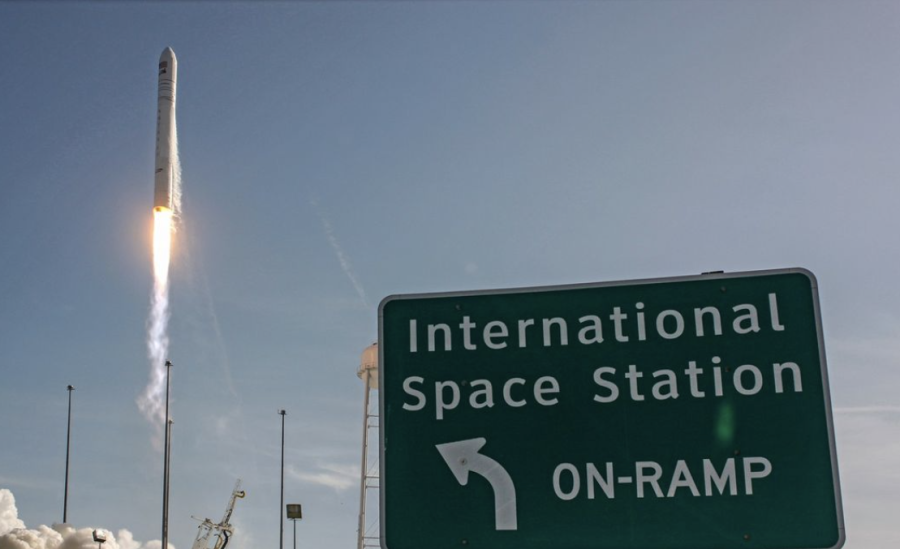The International Space Station’s orbit is coming to an end
March 17, 2022
NASA’s International Space Station (ISS) has been in orbit above Earth for almost 24 years now, but its orbit is soon coming to an end, predicted to fall in 2031 into the Pacific Ocean.
The ISS has been in orbit since 1998 and has been continuously occupied since 2000 with an overall mission to provide a foundation to continue human spaceflight beyond low-Earth orbit to the Moon and Mars. This large spacecraft orbits the Earth and is home to many astronauts, serving as a science laboratory and living quarters in space. The space station was assembled by several different Nations and their participating space agencies: NASA (United States), Roscosmos (Russia), JAXA (Japan), ESA (Europe) and CSA (Canada).
It took 42 separate launches to fully construct the ISS and is 365 feet long, just one yard shy of being the full length of a football field orbiting our planet, with a crew of seven people living and working on the space station at a time. The station travels at 17, 500 mph, the equivalent of five miles per second, orbiting the Earth every 90 minutes. As of Sept. 2021, 244 individuals have been on the ISS, with most scientists coming from the U.S. and Russia. These crew members spend about six months on the station during their expeditions and are currently on their 66th expedition that began in Oct. 2021 and will end in March 2022.
Expedition 66 is providing seven astronauts the unique opportunity to conduct experiments that could help scientists on Earth “identify new materials with innate antimicrobial properties that could be used in designing future spacecraft. New hydrogen sensors will be tested on the station’s oxygen generation system to determine their stability over time. Astronauts will also manufacture optical fibers in microgravity, and contribute to research aimed at improving the infectious disease risk assessment for astronauts,” according to NASA’s Mission Summary.
The space station will continue working until 2030 then crash in early 2031 into a part of the Pacific Ocean called Point Nemo, the farthest part of the ocean from any land and also known as the spacecraft cemetery. The point is also not very biologically diverse according to a space debris expert, making it a practical point for spacecraft to fall.
Approximately 250-300 spacecraft have fallen into Point Nemo. The largest object to land into Point Nemo was Russia’s MIR space lab, which weighed 120 tons. The Soviet Union launched this space station into orbit and it lasted 15 years in space before falling in 2001, serving as a laboratory for 23,00 scientific and medical experiments. This space station left large debris reentering the atmosphere and into the Pacific Ocean.
NASA’s last complete analysis predicts that the ISS’ life will end in 2028, however they are confident that it will remain functional until 2030, then will plummet into Point Nemo. The deorbit of the ISS wasn’t in the minds of NASA scientists until about five years ago. Because it is a product of an international partnership, the other space agencies involved will also have to sign on to deorbiting the station.
View this post on Instagram
The fall of the ISS, however, does require planning so that it does not come down unpredictably as the NASA Skylab did in 1979. The Skylab fell without proper planning, and many large chunks of the aircraft, including a large oxygen tank, reentered the atmosphere and landed in Australia. Because the ISS is much larger compared to the 80-ton Skylab, scientists are preparing plans on how to safely take it out of orbit. Because the aircraft is so much larger, it is less likely to break apart into smaller, less harmful pieces as it reenters the atmosphere
The current plans for deorbiting the ISS are based on similar plans for the MIR. However, the larger size of the ISS will not play into any changes to this plan. The current plan mirrors how the spacecraft normally maintains its altitude. Russian Progress Spaceships are what have been delivering food and supplies to the ISS since 2001.
These aircrafts are sent to the ISS three to four times every year. These spacecrafts are single-use and unpiloted but they can be controlled, if needed, by the astronauts on the space station. These vehicles dock on the station and will either transfer fuel to the main thrusters or will conduct a burn for the station to climb in altitude.
However, to deorbit the station, will happen in the reverse direction and will send the station down, closer to earth. It is predicted that three of these Progress spacecrafts will be needed to deorbit the station. The burning of these Progress spacecrafts will be controlled, letting scientists have some predictability of where the station will reenter orbit, but could potentially be thrown off if a burn is off-schedule.
Many private companies are already planning on their own space station launches, and NASA is planning on renting out facilities on them to continue their research. Because the stations will be smaller and not owned by NASA, they will no longer have to pay the $4 billion cost of maintaining the aircraft. This change could save NASA an estimated $1 billion every year.
NASA is also planning on launching a space station near the moon, with a spacecraft carrying the living quarters set to launch in 2024. Other countries are also planning on launching their own low-orbit stations, including China, Russia, and India. With their own ventures in mind, countries might also leave the ISS sooner than its de-orbit. Russia may leave by 2025, five years before the predicted fall of the station.
While this is the end of a chapter for space travel, NASA plans to switch gears and continue research outside of our atmosphere. According to NASA’s plans, they intend to construct permanent living quarters on the moon. They are set to launch a space station named the Gateway, that instead of orbiting Earth, will orbit the moon. This station will be able to fit four astronauts and will be used as a place to land before going to the moon or returning to Earth. This space station will also aid in simulation missions to Mars.












